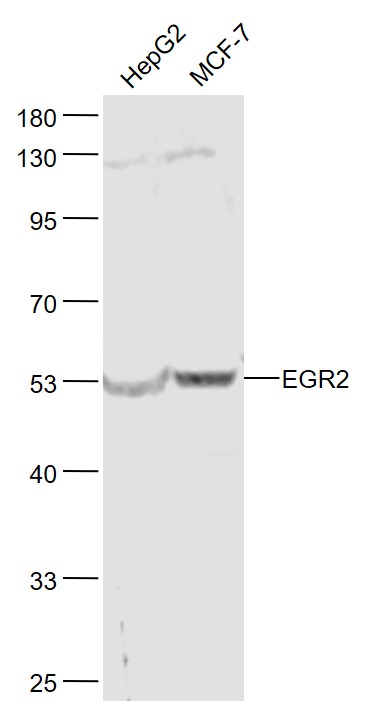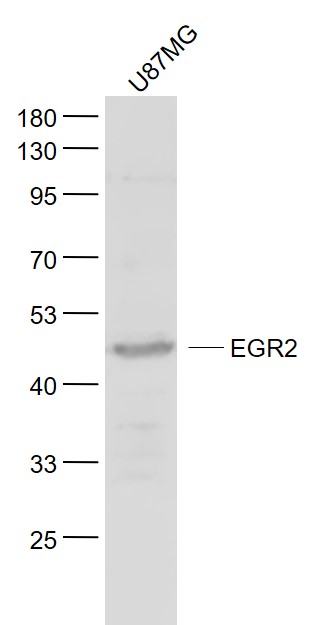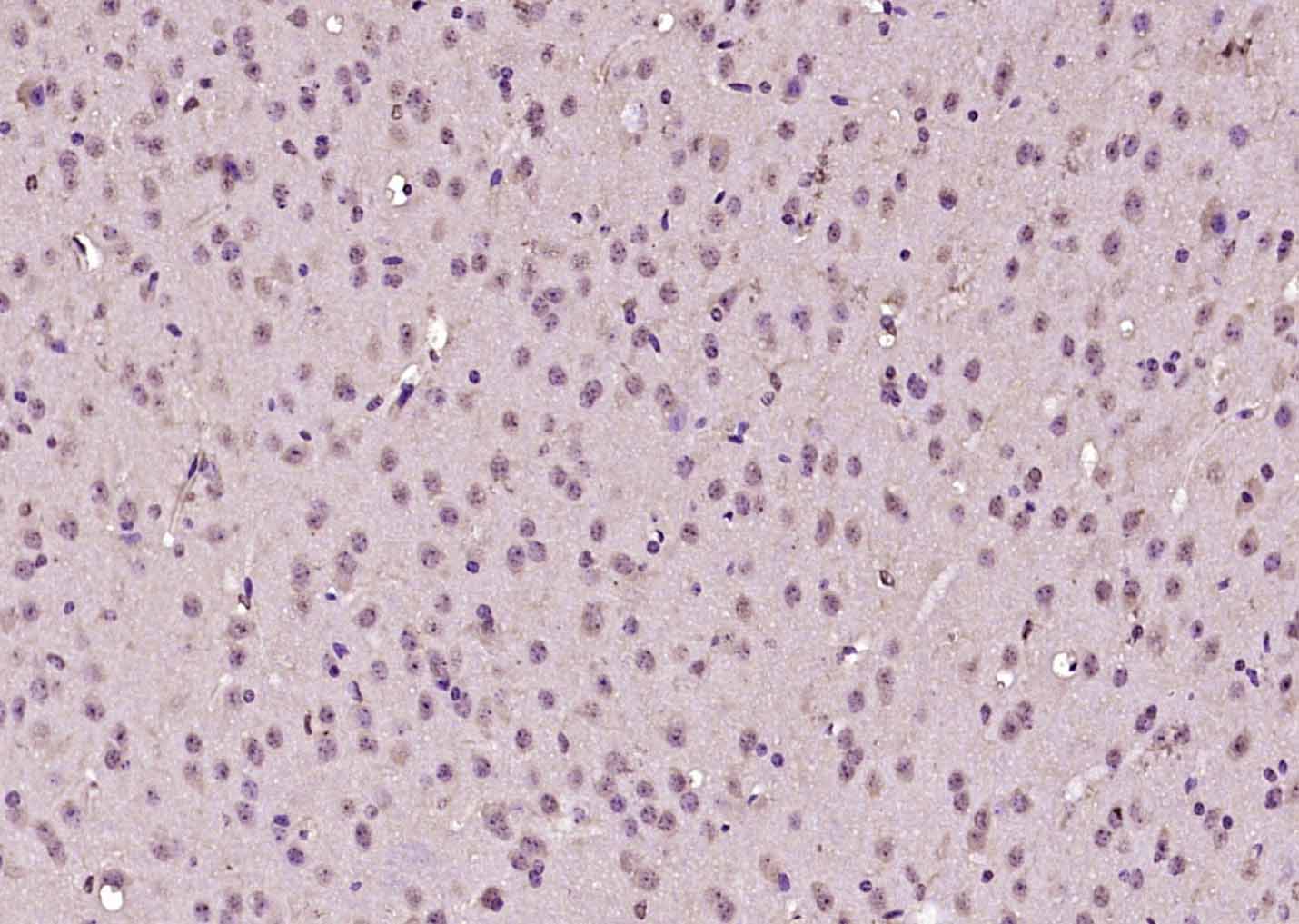
Rabbit Anti-EGR2 antibody
CMT1D; CMT4E; DKFZp686J1957; Early growth response 2; Early growth response protein 2; EGR-2; egr2; EGR2_HUMAN; FLJ14547; KROX 20 Drosophila homolog; Krox 20 homolog Drosophila; KROX20; Krox20 protein; Zinc finger protein Krox-20; AT591.
View History [Clear]
Details
Product Name EGR2 Chinese Name 早期生长反应蛋白2抗体 Alias CMT1D; CMT4E; DKFZp686J1957; Early growth response 2; Early growth response protein 2; EGR-2; egr2; EGR2_HUMAN; FLJ14547; KROX 20 Drosophila homolog; Krox 20 homolog Drosophila; KROX20; Krox20 protein; Zinc finger protein Krox-20; AT591. literatures Research Area Cell biology immunology Neurobiology Signal transduction Epigenetics Immunogen Species Rabbit Clonality Polyclonal React Species Human, Mouse, (predicted: Rat, ) Applications WB=1:500-2000 ELISA=1:5000-10000 IHC-P=1:100-500 IHC-F=1:100-500 IF=1:50-200 (Paraffin sections need antigen repair)
not yet tested in other applications.
optimal dilutions/concentrations should be determined by the end user.Theoretical molecular weight 50kDa Cellular localization The nucleus Form Liquid Concentration 1mg/ml immunogen KLH conjugated synthetic peptide derived from human EGR2: 351-450/476 Lsotype IgG Purification affinity purified by Protein A Buffer Solution 0.01M TBS(pH7.4) with 1% BSA, 0.03% Proclin300 and 50% Glycerol. Storage Shipped at 4℃. Store at -20 °C for one year. Avoid repeated freeze/thaw cycles. Attention This product as supplied is intended for research use only, not for use in human, therapeutic or diagnostic applications. PubMed PubMed Product Detail Egr proteins function in transcription regulatory activities surrounding cellular growth, differentiation and function. The deduced amino acid sequences of human Egr-2 and mouse Egr-1 are 92% identical in the zinc finger region but show no homology elsewhere. Egr-2 is a sequence-specific DNA-binding transcription factor that binds two specific DNA sites located in the promoter region of HoxA4 and localizes to the nucleus. Defects in the Egr-2 protein are a cause of congenital hypomyelination neuropathy (CHN). CHN is characterized clinically by early onset of hypotonia, areflexia, distal muscle weakness and very slow nerve conduction velocities. Mutations in the gene that encodes Egr-2 (EGR2) also cause Dejerine-Sottas syndrome (DSS), which is also known as Dejerine-Sottas neuropathy (DSN) or hereditary motor and sensory neuropathy III (HMSN3). DSS patients exhibit severe early onset motor and sensory neuropathy with very slow nerve conduction velocities and elevated cerebrospinal fluid protein concentrations.
Function:
Sequence-specific DNA-binding transcription factor. Binds to two specific DNA sites located in the promoter region of HOXA4.
E3 SUMO-protein ligase helping SUMO1 conjugation to its coregulators NAB1 and NAB2, whose sumoylation down-regulates EGR2 own transcriptional activity.
Subunit:
Interacts with HCFC1. Interacts with WWP2. Interacts with UBC9.
Subcellular Location:
Nucleus.
Post-translational modifications:
Ubiquitinated by WWP2 leading to proteasomal degradation (By similarity).
DISEASE:
Defects in EGR2 are a cause of congenital hypomyelination neuropathy (CHN) [MIM:605253]. Inheritance can be autosomal dominant or recessive. Recessive CHN is also known as Charcot-Marie-Tooth disease type 4E (CMT4E). CHN is characterized clinically by early onset of hypotonia, areflexia, distal muscle weakness, and very slow nerve conduction velocities.
Defects in EGR2 are a cause of Charcot-Marie-Tooth disease type 1D (CMT1D) [MIM:607678]. CMT1D is a form of Charcot-Marie-Tooth disease, the most common inherited disorder of the peripheral nervous system. Charcot-Marie-Tooth disease is classified in two main groups on the basis of electrophysiologic properties and histopathology: primary peripheral demyelinating neuropathy or CMT1, and primary peripheral axonal neuropathy or CMT2. Neuropathies of the CMT1 group are characterized by severely reduced nerve conduction velocities (less than 38 m/sec), segmental demyelination and remyelination with onion bulb formations on nerve biopsy, slowly progressive distal muscle atrophy and weakness, absent deep tendon reflexes, and hollow feet.
Defects in EGR2 are a cause of Dejerine-Sottas syndrome (DSS) [MIM:145900]; also known as Dejerine-Sottas neuropathy (DSN) or hereditary motor and sensory neuropathy III (HMSN3). DSS is a severe degenerating neuropathy of the demyelinating Charcot-Marie-Tooth disease category, with onset by age 2 years. DSS is characterized by motor and sensory neuropathy with very slow nerve conduction velocities, increased cerebrospinal fluid protein concentrations, hypertrophic nerve changes, delayed age of walking as well as areflexia. There are both autosomal dominant and autosomal recessive forms of Dejerine-Sottas syndrome.
Similarity:
Belongs to the EGR C2H2-type zinc-finger protein family.
Contains 3 C2H2-type zinc fingers.
SWISS:
P11161
Gene ID:
1959
Database links:Entrez Gene: 1959 Human
Entrez Gene: 13654 Mouse
GenBank: BC035625 Human
Omim: 129010 Human
SwissProt: P11161 Human
SwissProt: P08152 Mouse
Unigene: 1395 Human
Unigene: 290421 Mouse
Unigene: 89235 Rat
Product Picture
HepG2(Human) Cell Lysate at 30 ug
MCF-7(Human) Cell Lysate at 30 ug
Primary: Anti- EGR2 (SL8368R) at 1/1000 dilution
Secondary: IRDye800CW Goat Anti-Rabbit IgG at 1/20000 dilution
Predicted band size: 50 kD
Observed band size: 52 kD
Sample:
U87mg (Mouse) Lysate at 40 ug
Primary: Anti- EGR2 (SL8368R) at 1/1000 dilution
Secondary: IRDye800CW Goat Anti-Rabbit IgG at 1/20000 dilution
Predicted band size: 50 kD
Observed band size: 50 kD
Paraformaldehyde-fixed, paraffin embedded (mouse brain); Antigen retrieval by boiling in sodium citrate buffer (pH6.0) for 15min; Block endogenous peroxidase by 3% hydrogen peroxide for 20 minutes; Blocking buffer (normal goat serum) at 37°C for 30min; Antibody incubation with (EGR2) Polyclonal Antibody, Unconjugated (SL8368R) at 1:200 overnight at 4°C, followed by operating according to SP Kit(Rabbit) (sp-0023) instructionsand DAB staining.
References (0)
No References
Bought notes(bought amounts latest0)
No one bought this product
User Comment(Total0User Comment Num)
- No comment





 +86 571 56623320
+86 571 56623320
 +86 18668110335
+86 18668110335

